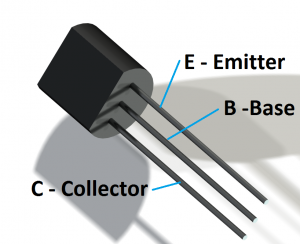 Transistors are one of the greatest inventions of all time. These little doohickies are what have made cool things like cell phones, computers, and just about anything tech-like possible. To keep things simple, we are going to look at one an example of a transistor. They all work pretty much the same, but there are a lot of different facts we don’t need to concern ourselves with at this point. So, here is a transistor:
Transistors are one of the greatest inventions of all time. These little doohickies are what have made cool things like cell phones, computers, and just about anything tech-like possible. To keep things simple, we are going to look at one an example of a transistor. They all work pretty much the same, but there are a lot of different facts we don’t need to concern ourselves with at this point. So, here is a transistor:
Notice that unlike most other electronic components, this one has three leads (wires) sticking out of it. Transistors are packaged a lot of different ways, but they almost all have three leads (you might try doing a google image search on transistor).
So what does a transistor do? Glad you asked. A transistor works like a faucet or water valve. In a water valve, there is a place for water to go in and place for water to go out. A valve also has a control (handle) that controls how much water should be flowing. On a transistor, these parts are called the collector, the emitter, and the base. Here look:
See. Just like I told you. Now, the collector is where the water electricity goes in, the emiter is where it goes out, and the base is what controls how much electricity flows. The more electricity you send to the base, the more electricity flows from the collector to the emitter (I like to remember that the “B” lead is the “button” you push to make it work). Don’t call it a button, though or people will laugh at you.
On a schematic, the symbol for a transistor usually looks like this:
It won’t have the B, C, and E labeled on it, though. If your transistor looks different from the one above, check the spec sheet to see which terminals are the base, collector and emitter.
Also, if the transistor symbol looks different from the one above, it is a different type. It will work a little differently, but the general idea is still the same. By the way, the one we are using is a NPN style transistor if you were wondering. Most of our projects will use this type of transistor (actually a model BC547 NPN Transistor to be exact).


